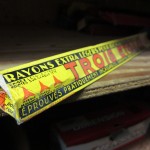 Here are some quick issues with spokes: So long as a rim is not bent and spokes are not corroded; most nipples don’t turn well firstly because of friction at the nipple head. Lubing the nipple seat (between head and rim) can avoid rounding as will the use of a socket type spoke wrench (slotted “Spokey” four-side-contact type).
Here are some quick issues with spokes: So long as a rim is not bent and spokes are not corroded; most nipples don’t turn well firstly because of friction at the nipple head. Lubing the nipple seat (between head and rim) can avoid rounding as will the use of a socket type spoke wrench (slotted “Spokey” four-side-contact type).
Although some sort of thread compound (traditionally linseed oil) on the threads of the spokes can help lessen friction and dampen road vibration, what will keep a wheel true is the quality of components and tension of spokes. In an ideal world a rim would be perfectly made and machined and the spokes on a wheel would/could all be equally tensioned when true(drive side vs. non drive of course would differ). Reaching this ideal is not likely to happen but it is a goal worth shooting for as it can improve the wheels lifetime expectancy/ performance.
Older, lesser quality rims/ spokes and hubs could and can only take so much tensions before reaching their fatigue limits. Extremely stiff modern and “v” section rims are capable of higher tensions (providing spokes and hubs are also up to the task) and stay true primarily through their own shear strength. Getting even tension across all the spokes can only help. Unfortunately it is quite easy to true these wheels without worrying about even tension.
Imagine a wheel which is true- perhaps with a slight bit of out-of-roundness- and yet has several spokes with quite varying spoke tensions. The ones with higher tension are doing more work while the lower tensioned ones are just slacking off- and run the risk of loosening up further. The wheel may appear and function fine at first, but overtime be more prone to premature wobble or even broken spokes.
Try evening out tension while in a low tension state and bring the tension up gradually, checking relative tension by feel at first and latter by plucking them. When choosing spokes to bring a wheel into true, choose ones which may best help achieve or maintain even tension whenever possible. Spread out any necessary unevenness in tension gradually, over several spokes rather than at a precipitous single point. And yes: the seam will likely never be perfect, some rims/ spokes/ hubs are stiffer, tend not to break or have a better track record than others. But in an ideal world….
Note: Replacing broken spokes: All too often I see wheels with 2, 3, 4, 11..newer DT, Wheelsmith, etc spokes mixed in among the originals. This should say something to you. Replacing one bad spoke (okay, maybe it was an anaomoly), or those bent/ damaged can be understandable. But even just two (2) broken spokes is likely cause for alarm. If you want a reliable wheel you have to address the problem: The spokes are fatigued, two short or just sucky and need to be replaced with ones that can support the rider and transmission torques required of them.
Spokes ideally should come right up to the end of the nipple head to maximize thread contact to 1) help prevent nipple breaking 2) maximize thread contact to avoid detensioning
Wheels can actually de-tension themselves if spokes are too short and rider is especially, shall we say, burly.
